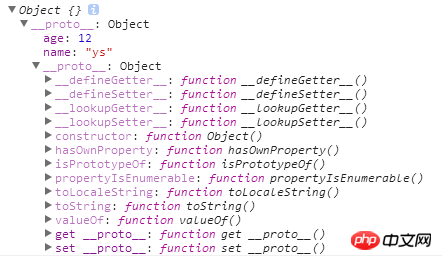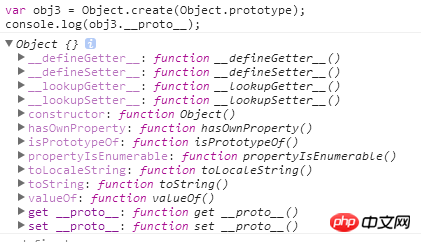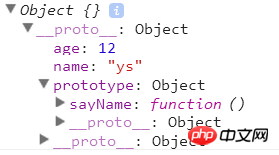Home >Web Front-end >JS Tutorial >Summary of methods for creating objects in js (sample code)
Summary of methods for creating objects in js (sample code)
- 怪我咯Original
- 2017-07-07 10:32:301156browse
This article mainly introduces the methods of creating objects in js. There are three methods to create objects in js. Here is a summary for everyone. Interested friends can refer to it
js has three methods to create objects. Here is a summary.1. Object direct quantity
The so-called object direct quantity can be regarded as a mapping table , this method is also the most direct method. I personally recommend,//创建简单对象
var obj1 = {}; //空对象
var obj2 = {
name: "ys",
age: 12
};
//创建复杂对象
var obj3 = {
name: "ys",
age: 12,
like: {
drink: "water",
eat: "food"
}
};
console.log(typeof obj1); //object
console.log(typeof obj2); //object
console.log(typeof obj3); //objectSome people may find that the key value name here does not have quotation marks "", so be careful. In fact, this quotation mark (single quotation mark and double quotation mark , js is the same) you can add it or not, but I personally recommend adding it. Why is it possible? Because after adding it, the key value name can be very arbitrary... Of course, if you don't define the name randomly, the first one is better. It depends on the person. Different, var obj4 = {
"my name": "ys", //键值名中间有空格
"my-age": 12, //键值名中间有连字符
"while": 111 //键值名是关键字
}
console.log(obj4['my name']); //ys
console.log(obj4['my-age']); //12
console.log(obj4.while); //111
console.log(typeof obj3); //objectThrough the above example, you can see the difference between "." and "[]" to access properties, right?The object is created directly, and the value of the key-value pair Support expression, as follows
var obj3 = {
name: "ys",
age: obj2.age, //引用obj2.age
like: {
drink: "water",
eat: "food"
}
};
console.log(obj3.age); //100
2.new creates object
1).System built-in object
var obj1 = new Object();
var obj2 = new Array();
var obj3 = new Date();
var obj4 = new RegExp("ys");
console.log(typeof obj1); //object
console.log(typeof obj2); //object
console.log(typeof obj3); //object
console.log(typeof obj4); //object
2).Custom object
function Person(name, age){
this.name = name;
this.age = age;
}
var obj1 = new Person("ys", 12);
console.log(Object.prototype.toString.call(obj1)); //object
console.log(Person instanceof Object); //true
console.log(typeof obj1); //object
console.log(obj1.age); //12
3.Object.create() creates
This method has two parameters. I will only explain the first parameter. The second parameter is not commonly used (further describe the properties of the object)The first parameter: Pass in the prototype to be inherited. (prototype) object
How to understand this sentence?
var obj1 = Object.create({
name: "ys",
age: 12
});
console.log(obj1); //{}
console.log(obj1.age); //12obj1 is {}, why can the attribute value be accessed? Let’s understand the meaning of the first parameter “pass in the prototype object to be inherited” console.log(obj1.proto); //Object {name: "ys", age : 12}
The object itself is empty, but the data on the prototype chain is not empty. obj1.age exists, so it can be accessed.1). When the first parameter is null
var obj2 = Object.create(null); //不继承对象应有的属性和方法 console.log(obj2 + "abc"); //报错 ,失去 + 功能Why does it report an error? The diagram generated under normal parameters is as follows:

JavaScript inherit from Object, and Object is considered to be at the top of the inheritance chain.
2). Create an empty object
var obj3 = Object.create(Object.prototype);
console.log(obj3); //{},(空对象,与前两个方法 {},new Object 相同)
console.log(obj3.proto); //如下图 ,只包含了基本对象的方法 Picture of the code:

3). Finally, everyone looks at the following code, hoping to have a deeper understanding of the Object.create() method. You can refer to this article: 《A new javascript object creation method Object.create()》
var obj1 = {
name: "ys",
age: 12
};
obj1.prototype = {
sayName: function(){
return console.log(this.name);
}
};/*①对象参数,只继承对象*/
var obj2 = Object.create(obj1);
console.log(obj2); //{}
console.log(obj2.name); //ys
/*console.log(obj2.sayName());*/ /* 报错 obj2.sayName is not a function*/
console.log(obj2.proto.prototype.sayName()); //ys 理解原型的原型If you don’t understand, look at the picture below

/*②对象原型,继承对象原型*/
var obj3 = Object.create(obj1.prototype);
console.log(obj3); //{}
console.log(obj3.name); //undefined,没有继承对象本身
obj3.name = "ys";
console.log(obj3.name); //ys
console.log(obj3.sayName()); //ysThe code does not understand the picture (picture after setting the name):

The above is the detailed content of Summary of methods for creating objects in js (sample code). For more information, please follow other related articles on the PHP Chinese website!
Related articles
See more- An in-depth analysis of the Bootstrap list group component
- Detailed explanation of JavaScript function currying
- Complete example of JS password generation and strength detection (with demo source code download)
- Angularjs integrates WeChat UI (weui)
- How to quickly switch between Traditional Chinese and Simplified Chinese with JavaScript and the trick for websites to support switching between Simplified and Traditional Chinese_javascript skills

